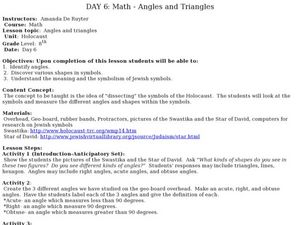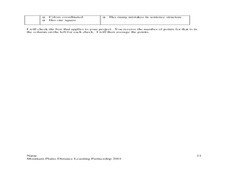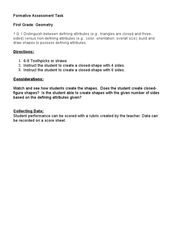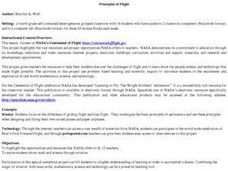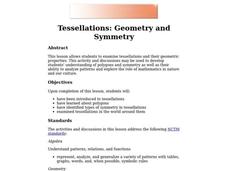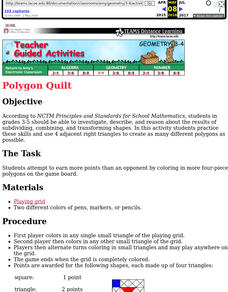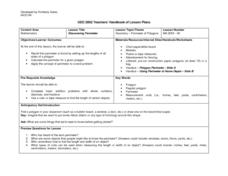Curated OER
Introducing Angles
Sixth graders identify, compare and interpret the characteristics of polygons and angles in order to meet spatial sense, geometry and measurement standards. They also sort shapes into three categories, polygons (regular and irregular)...
Curated OER
2-D Geometry
Third graders describe and compare attributes of two-dimensional shapes. They explain geometric terms, angles and shapes. Students demonstrate each vocabulary word with their body and they mirror the body positions associated with each...
Curated OER
Polygon Perimeters
Students define the terms polygon and perimeter to begin the lesson. Using a calculator, they practice determining the perimeter of various symbols in a painting. They discuss how geometry and art are related to one another.
Curated OER
Angles And Triangles
Seventh graders participate in a lesson that is focused upon the concepts of classifying different angles and triangles. They practice classifying triangles according to its kind that includes types of angles, congruence, and vertices....
Curated OER
Solve for Scale Factors Using Proportions
Eighth graders solve problems using proportions with scaled drawings. They work with maps and blue-prints discussing scales and plans and examine different polygons and figure out the scale factors or proportions they have been changed by.
Curated OER
2-D Polygons
Learners investigate the concept of two dimensional polygons. They complete a vocabulary chart with the teacher or in independently. Students are shown various polygons in order to classify them and then asked to draw one of them from...
Curated OER
Algebraic Processes And Its Connection To Geometry
Students investigate the concept of polygons using a variety of activities. They explore the vocabulary of polygons by constructing a graphic organizer. Then students categorize the characteristics of several polygons and contribute the...
Curated OER
Reflections
Fifth graders create a reflection of a poygon using a Mira. They discover that a line connecting a vertiex of a polygon and the corresponding vertex of its reflection is perpendicular to the line of reflection. Students create a glide...
Curated OER
Quilt Squares
Students research the history of the quilt in American History and view a PowerPoint Presentation. They create a quilt square with colored paper using polygons, transformations, rotations, and reflections on the computer and on a...
Curated OER
Tessellation Trial and Error
In this interactive lesson, pupils review attributes of equilateral polygons. They are introduced to the concept of a tessellation. Using protractors and pre-cut shapes, students arrange a variety of tiles to create tessellations. They...
Curated OER
Quilt Geometry
Seventh graders explore lines of symmetry, congruent polygons and patterns. They listen to "The Seasons Sewn," observe a PowerPoint presentation, and identify congruent polygons and visual patterns. Through an internet activity, 7th...
Curated OER
Pondering Polygons
Seventh graders use block letter writing to help classify polygons. They use their own names which helps to keep them engaged during the lesson. Finally, 7th graders play a classification game naming different polygons.
Curated OER
Polygon Monster
Young scholars brainstorm different kinds of shapes. They then draw them on the paper and write the name of the shape on the back and then assemble the shapes to make a "monster". Students make up a survey about the monster including its...
Curated OER
Strut Your Stuff
Students begin the lesson by identifying what a polygon is and hypothesizing how many struts (diagonals) it would take to make a polygon rigid. They watch a "Magic School Bus" episode then experiment with various shapes to make a...
Curated OER
Geometry and Shapes in the X-36
Students describe, draw, and classify shapes. They use the internet to research the X-36 aircraft. Students identify the geometric shapes in the aircraft. They calculate the number of sides in an x-36.
Curated OER
Geometry
Students are introduced to the basics of Geometry. Using cutout shapes, they identify whether they are polygons by using the properties of polygons. They practice drawing shapes they are going to be using on an everyday basis and...
Curated OER
Areeas of Parallelograms and Triangles
Twelfth graders are able to deduce the area of polygons by using several methods such as coordinate method. They are able to apply the area of polygons to real life situations. Students apply the Pythagorean Theorem in problem solving...
Curated OER
Finding Areas of Plane Figures
Learners compute areas of squares, rectangles, and so on and summarize the formulas for computing areas and explain how the formulas are derived and understand the reasoning behind them.
Curated OER
Dayna Lykins, Leanna Prater
Fourth graders compare and contrast gliding flight and true flight. They investigate the basic principles of aeronautics. The class participates in activities to observe lift and the effect of air. Students design and fly their own...
Curated OER
Tessellations: Geometry and Symmetry
Students examine tesselllations and their geometric properties. They have a better knowledge of polygons, can identify types of symmetry in tessellations. Also students use visulization, spatial reasoning, and geometric modeling to...
Curated OER
Mathematics in Art?
Fifth graders view prints of M.C. Escher's work. They look at examples of geometric figures and polygons and discuss places they have seen them. Students create their own tessellations. They write a report about the process they used in...
Curated OER
Polygon Quilt
Students participate in a game with different types of polygons. They use triangles to create as many polygons as possible. They also review their colors by having different polygons be a different color.
Curated OER
Geo-Mat
Students review plane figures by playing a game that resembles "Twister." They listen to directions to locate a large example of the figure which is placed on the floor.
Curated OER
Discovering Perimeter
Twelfth graders apply perimeter measurement to items found in newspapers and calculate the cost in terms of feet or yards. They share answers and explanations with classmates.





